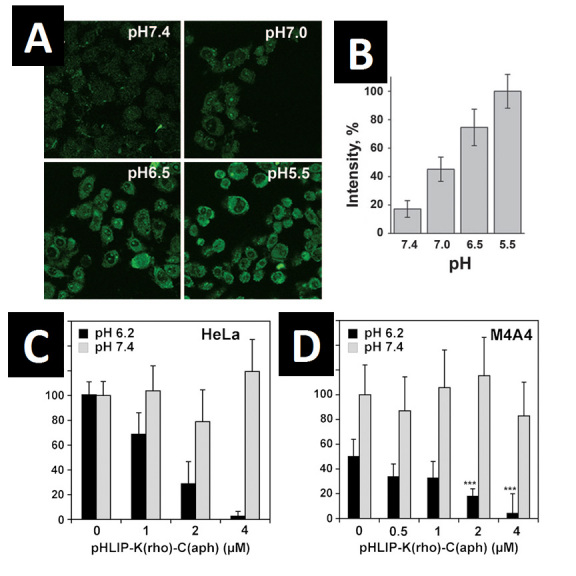Figure 3.

pHLIP can translocate cargo molecules across a lipid bilayer at low pH. A) HeLa cells were incubated for 15 minutes with 7 µM cleavable pHLIP-S-S-dansyl at extracellular pH of 5.5, 6.5, 7.0, or 7.4, followed by many pH 7.4 PBS washes to remove inserted peptide. The observed fluorescence is from the dansyl dye retained in the cells after disulfide cleavage and peptide removal. pH treatment values more acidic than the typical pH of an in vivo solid tumor were used to accelerate the translocation process. B) Quantification of the retained dye fluorescence in (A). The signal from cells at pH 5.5 was taken as 100 percent. Dye retention strongly decreases with an increase in extracellular pH. C) HeLa cell growth is strongly inhibited with incubation of increasing concentrations of a cleavable pHLIP-S-S-phalloidin construct at low extracellular pH. HeLa cells were incubated with 1, 2, or 4 μM pHLIP-S-S-phalloidin for 3 hours at pH 6.2 (black bars) or 7.4 (gray). After 4 days growth, the number of remaining viable cells was determined using the Promega AQueous One assay. All readings are normalized to a 0 μM peptide, pH 7.4 control. Errors of the mean were estimated using the two-tailed Student t distribution. D) Same experiment as in (C) using M4A4 cells instead of HeLa. Relabeled figures reprinted according to permissions guidelines: A-C: Reshetnyak YK, et al. Translocation of molecules into cells by pH-dependent insertion of a transmembrane helix. Proc Natl Acad Sci USA. 2006;103(17):6460-5 [14]; D: An M, et al. pH-(low)-insertion-peptide (pHLIP) translocation of membrane impermeable phalloidin toxin inhibits cancer cell proliferation. Proc Natl Acad Sci USA. 2010;107(47):20246-50 [19].
